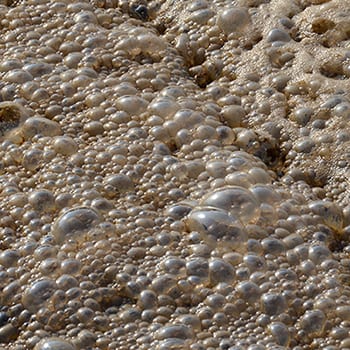Choosing the Right Defoamer for Your Specific Application Needs
Selecting the appropriate defoamer for particular application requirements is a nuanced procedure that demands careful consideration of several elements, such as the foam tool, kind, and operating conditions. Comprehending the nuances of defoamer efficiency-- including rate and persistence-- while also accounting for regulative and environmental variables is vital.
Understanding Foam Formation
Foam development takes place when gas is trapped within a fluid, creating a steady structure of bubbles. This sensation can substantially impact various industrial procedures, specifically in industries such as food production, drugs, and wastewater therapy. The visibility of foam can prevent mixing, minimize product high quality, and also bring about operational inefficiencies.
Foam generally develops because of a combination of factors, including surface-active agents, frustration, and the characteristics of the fluid phase. Surfactants reduced the surface area stress of the liquid, promoting the formation of bubbles that can maintain and coalesce. Agitation, whether from mechanical mixing or gas intro, boosts bubble formation, causing enhanced foam quantity.
Comprehending the technicians of foam development is critical for markets aiming to maximize their procedures. By recognizing the particular problems that advertise foam generation, organizations can carry out strategies to alleviate its results.
Sorts Of Defoamers Available
Various kinds of defoamers are readily available to deal with the challenges posed by foam in commercial applications. defoamers. Broadly categorized, defoamers drop into three classifications: silicone-based, non-silicone-based, and natural defoamers
Silicone-based defoamers are renowned for their performance and security throughout a variety of temperatures and pH levels. They are typically made use of in applications where solid foam reductions is needed, such as in layers, adhesives, and paints. Their low surface stress allows for fast foam collapse.
Non-silicone-based defoamers, often made from organic compounds, use an alternative for applications sensitive to silicone residues. These defoamers can be further divided right into polyether and ester types, each tailored to satisfy certain formulation demands. Non-silicone defoamers are often made use of in food processing and individual treatment items due to their compatibility with different solutions.
Natural defoamers, obtained from plant or animal resources, are obtaining grip due to their green profile. These items are especially appealing in applications where regulative compliance and sustainability are extremely important, such as in agrochemicals and biotechnology.
Picking the best kind of defoamer is critical for maximizing performance and ensuring compatibility with specific applications.
Trick Application Factors To Consider
When picking a defoamer, it is necessary to take into consideration the specific application demands to ensure optimum efficiency. defoamers. Various industries have distinct needs, such as food handling, drugs, or wastewater therapy, and each application may require special defoaming buildings
Key elements to examine include the tool in which the defoamer will certainly be utilized, whether it is water-based, oil-based, or a combination thereof. The temperature level and pH degrees of the application can likewise significantly influence the effectiveness of a defoamer. Furthermore, compatibility with other chemicals existing in the system is essential to avoid negative reactions that might jeopardize efficiency.
Another important consideration is the foaming behavior of the particular system. Recognizing whether the foam creates swiftly or gradually can direct the option of a defoamer that targets the root reason efficiently. The wanted speed of defoaming can influence the selection, as some applications need fast action while others may endure slower defoaming processes.
Finally, governing and environmental factors to consider need to not be ignored, specifically in sectors with rigorous conformity needs. Picking a defoamer that aligns with these aspects ensures both effectiveness and safety and security in the application.

Performance Screening Approaches
Assessing the efficiency of a defoamer calls for a systematic approach to testing that their explanation accurately gauges its performance in details applications. Numerous performance testing techniques can be employed to ascertain the optimum defoamer for a provided solution.
One usual approach is the bubble test, which reviews the defoamer's ability to reduce foam quantity over time. This examination includes generating a steady foam and then including the defoamer to observe the rate of foam collapse.
.png?width=250&height=140&name=35722%20BOR%20Defoamers%20Ad_V8-BACKGROUND%20(2).png)
Eventually, selecting the appropriate performance testing approach depends on the certain application and the kind of foam being like this resolved. Each technique provides important information that can direct formulation modifications and enhance the efficiency of the defoamer in sensible applications.
Ideal Practices for Option


Next, consider the defoamer's performance in terms of speed of activity and determination. A quick-acting defoamer might be needed for procedures where fast foam reductions is vital, while an extra relentless solution might be needed for long term foam control. Additionally, examine the environmental impact of the defoamer, including its biodegradability and any type of regulative compliance demands.
Conduct tests with chosen defoamers to determine their efficiency in real-world conditions. By sticking to these best practices, you can enhance foam control performance and ensure the long life of your procedures.
Final Thought
In summary, choosing the suitable defoamer necessitates a thorough analysis of numerous variables, consisting of foam type, tool, operating conditions, and environmental considerations. Recognizing the special characteristics of foam development and the available defoamer alternatives is crucial. Furthermore, using effective performance testing methods and sticking to best techniques during the selection process will certainly improve the probability of attaining optimal defoaming outcomes. Ultimately, an educated choice technique will deal with certain application demands and alleviate lathering challenges efficiently.
Choosing the proper defoamer for specific sites application demands is a nuanced procedure that demands mindful factor to consider of numerous variables, such as the foam medium, kind, and operating conditions.Picking the best defoamer is important for attaining ideal efficiency in foam control applications. A quick-acting defoamer may be required for procedures where rapid foam suppression is essential, while an extra relentless formula may be needed for prolonged foam control.In summary, selecting the appropriate defoamer demands a comprehensive assessment of numerous variables, consisting of foam kind, medium, operating problems, and ecological factors to consider. Understanding the unique characteristics of foam development and the readily available defoamer options is crucial.